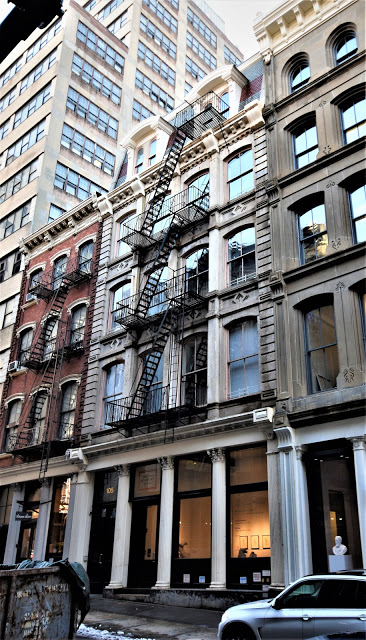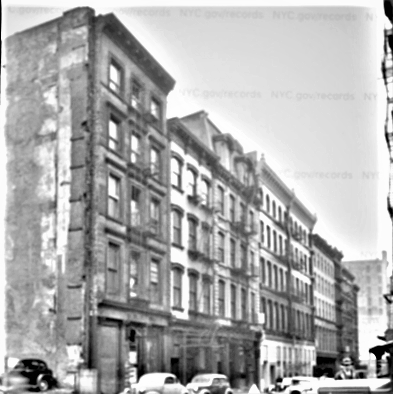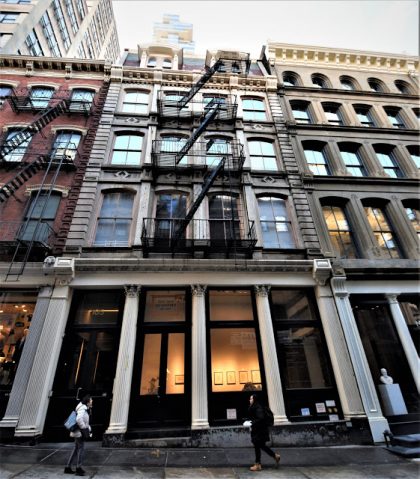The History of 105 Franklin
 Tom Miller, who writes about the history of Manhattan buildings at Daytonian in Manhattan, has allowed Tribeca Citizen to create a database of his Tribeca posts. If you enjoy these, and you will, then you should definitely check out his website, which also has write-ups about buildings all over the island. And don’t miss his book, Seeking New York: The Stories Behind the Historic Architecture of Manhattan—One Building at a Time.
Tom Miller, who writes about the history of Manhattan buildings at Daytonian in Manhattan, has allowed Tribeca Citizen to create a database of his Tribeca posts. If you enjoy these, and you will, then you should definitely check out his website, which also has write-ups about buildings all over the island. And don’t miss his book, Seeking New York: The Stories Behind the Historic Architecture of Manhattan—One Building at a Time.
··································
In 1849 a major outbreak of cholera occurred in Paris and then in London where it claimed 14,137 lives. The horrific disease spread to Ireland where many survivors of the Irish Famine, already weakened by starvation, fell victims. That year 5,308 people died in Liverpool, England, a major port used by immigrants heading to North America. They carried the disease with them, fueling a pandemic.
Cholera spread with lightning speed, killing tens of thousands in New York City and St. Louis in 1849, including the former president of the United States, James K. Polk.
The New York City government formed the Cholera Committee under the auspices of the 10 governors of Blackwell’s Island. As existing facilities to handle the sick were taxed, the city converted a stable building on Franklin Street between Church and West Broadway. On June 28, 1854, the New-York Daily Tribune reported that “a communication was received from N. C. Ely, acting Mayor and Chairman of the Health Commissioners, stating that a hospital for the reception of cholera patients was being established at No. 105 Franklin-st, and stating that they were in want of twenty bedsteads, bedding, &c. for the same.”
The pandemic would not be quelled until 1860. Following the crisis, the stable returned to its former purposes. In March 1864 merchant Charles Denison purchased it from Israel Cook, apparently as an investment. He seems to have soon come to an agreement with his tenant, N. Kingsley & Son, to vacate the building. An advertisement in The New York Herald on June 8, 1866 read: Livery Stock for Sale–The whole stock of Livery, consisting of single and pairs of Horses, Wagons, Harness, Sleighs, Coaches, Robes and Blankets. Sold at a sacrifice, on account of going out of business.
Denison hired architect Alexander G. Cutler to design a replacement loft building on the site. The 35-foot wide structure, completed the following year, was the last word in commercial elegance. Above the cast iron storefront a white marble facade rose three stories to a mansard roof. The French Second Empire style was relatively new to America and the polychrome tiles and prominent dormers of the mansard bespoke the latest in architectural fashion.
Among Denison’s first tenants were shirt manufacturer Isaac Rosenstein & Co. and Martin, Mills & Co., dry goods jobbers. As the years passed, other dry goods and apparel related firms came and went. In 1878 Herman Hessel, shirt maker, and dry goods merchant William Campbell were here. By 1884, towel and quilt manufacturer Gardner & Co., and woolens factory H. Crine leased space.
H. Crine was a substantial operation, run by Hannah Crine and her husband. The firm listed among its products “jackets, leggins and fancy knit goods.” The company was the victim of a prevalent crime of the period in 1890.
Some unprincipled fire fighters at the time took advantage of the confusion at fire scenes to grab valuable goods. It was a frequent complaint of shop owners and manufacturers. Two corrupt firefighters found themselves out of a job following a small blaze here in 1890. On May 17 The Evening World reported, “Firemen John L. Cleary and George J. Maguire, of Engine 27, who were charged with attempting to steal worsted shawls at the fire at 105 Franklin street, May 6, were dismissed from the Department to-day.”
In 1887 Hanna Crine had employed a young German immigrant, Lizzie Gunther, as a forewoman. She earned $25 per week, or about $681 today. Lizzie, like the other employees, was laid off while the fire damages were repaired. Nevertheless, she was paid. On March 17, 1891, The Sun explained, “After the fire that burned the factory last summer, her salary was paid to Jan. 1, 1891, as she had a contract.”
But Lizzie was battling other demons. On Monday, March 16, 1891, The Evening World reported “Lizzie Guther, a handsome young woman of thirty years, leaped from the roof of the six-story brick tenement, at 419 East Thirteenth street, at 5 o’clock this morning. She was killed instantly on striking the sidewalk, every bone in her body being broken. She was a forewoman of a woollen factory at 105 Franklin street.” The article added, “She was despondent over personal matters.”
Lizzie had developed what seems to have been paranoid delusions. Her landlady, Ms. Weimer, told investigators that two days earlier “Lizzie ran into her room and begged to be put into a closet, saying that her enemies were following her.”
The tortured woman had left a note, written in German, to her superintendent in the factory, Julius Homel. In it she thanked him for his kindness and “I send my thanks also to Mrs. Crine.” In part the long note said “My evil pursuers tried all in their power to get me out of the way,” and concluded “Lived-suffered. Amen.”
Other tenants during the 1890s included Trojan Shirt and Collar Co.; the Globe Knitting Mills; Dunbarton Flax Spinning Co., dealers in “linen yarns;” and Edman Bros., makers of knee pants (who would remain at least through 1907).
Fred F. Waters, cotton and linens merchants, were in the building by 1901 and would remain for decades. They were joined by 1905 by Tilton Mills, “fancy cassimeres and broadlooms;” Dickson & Hull, “southern cottons;” and cotton merchants E. Millus & Bro.
A much different sort of tenant, both in product and target customer, was marine hardware supplier Montgomery & Co., here by 1907. One of the company’s main customers at the time was the United States Navy. In 1907 it supplied bids for “280 square yards of sheet rubber” and 55 boat anchors. In May 1913 the firm advertised its maritime hardware to the general public in Popular Mechanics, offering “pulleys, hangers, gears, sprockets. Small sizes for models.”
Montgomery & Co. was the exception as No. 105 continued to attract dry goods firms. Dickson & Hull was still here in 1910; and by 1918 Kerr & Callihan, cotton goods merchants, was leasing space. The firm would remain at least through 1927, employing 125 workers. By then Valley Woolen Mills, flannels and dress goods was also here.
Things looked grim for No. 105 in the first years of the 1990s. The building sat vacant and seemingly neglected. But a renovation completed in 2011 resulted in six sprawling apartments above the ground floor and Alexander G. Cutler’s cutting edge 1867 edifice was returned to its original grandeur.
…………………………………….
All photo credits to Daytonian in Manhattan, unless otherwise noted
















